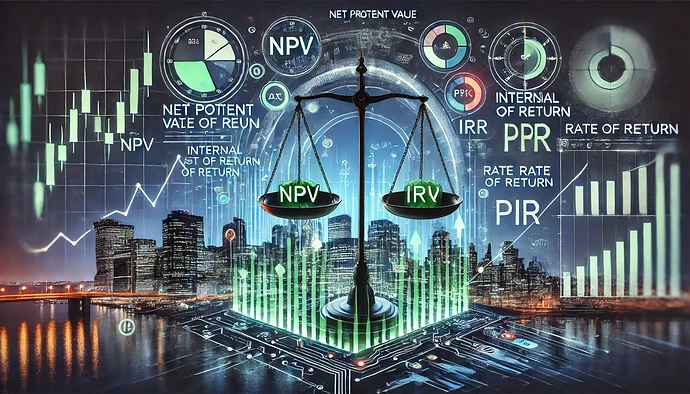Calculating the present value (PV) of costs in a real estate development pro forma or project feasibility analysis is essential for accurately assessing the financial viability of a project. It ensures that all future costs are evaluated in today’s dollars, allowing for better decision-making and a clearer understanding of the project’s potential profitability.
PV of Costs
1. Time Value of Money
- Concept Explanation: The time value of money principle states that a dollar today is worth more than a dollar in the future due to its potential earning capacity.
- Application: Costs and revenues in real estate projects often occur at different times. By discounting future costs back to their present value, you account for the fact that money spent in the future is not equivalent to money spent today.
2. Accurate Financial Comparison
- Uniform Basis: Present value calculations bring all cash flows—both incoming (revenues) and outgoing (costs)—to a common point in time. This makes it easier to compare and analyze them effectively.
- Net Present Value (NPV): By calculating the PV of costs and revenues, you can determine the NPV of the project, which indicates the expected profitability after considering the time value of money.
3. Investment Decision-Making
- Feasibility Assessment: Understanding the PV of costs helps developers and investors evaluate whether the expected returns justify the initial and ongoing expenditures.
- Opportunity Cost Consideration: Funds allocated to a project could be invested elsewhere. Present value calculations help assess if the project offers the best use of capital compared to alternative investments.
4. Risk and Inflation Adjustment
- Inflation Impact: Future costs may be higher due to inflation. Discounting future costs to their present value allows for more accurate budgeting and cost estimation.
- Risk Management: Present value analysis incorporates the risk associated with future cash flows by using a discount rate that reflects the project’s risk profile.
5. Financial Metrics Calculation
- Internal Rate of Return (IRR): Calculating the PV of costs is a step toward determining the IRR, which is crucial for assessing the project’s expected rate of return.
- Profitability Index: This metric, calculated using present values, helps compare different projects or investment opportunities.
6. Cash Flow Timing Impact
- Cash Flow Analysis: Real estate projects often have significant cash outflows upfront and inflows later. Present value calculations help visualize how timing affects the overall financial outcome.
- Delay Costs: Delays in the project can increase costs. Present value analysis quantifies the financial impact of such delays.
In essence, the PV of costs helps stakeholders make informed decisions by accurately reflecting the true economic cost of a project over time, considering both the time value of money and the associated risks.
Key Points to Consider
1. Positive Net Present Value (NPV)
- Definition: NPV is calculated by subtracting the PV of costs from the PV of expected revenues.
- Profitability Indicator: A project is generally considered profitable if the NPV is positive, meaning the discounted cash inflows exceed the discounted cash outflows.
- No Specific Range: The actual dollar amount of PV isn’t as important as whether the NPV is positive. A small project with a positive NPV is just as profitable (in relative terms) as a large project with a larger positive NPV.
2. Internal Rate of Return (IRR)
- Definition: IRR is the discount rate at which the NPV of all cash flows (both positive and negative) from a project equals zero.
- Benchmark Comparison: A project is considered acceptable if its IRR exceeds the required rate of return or the cost of capital.
- Profitability Threshold: There’s no standard IRR that defines profitability, but higher IRRs indicate more profitable projects, all else being equal.
3. Profitability Ratios
- Profitability Index (PI): Calculated by dividing the PV of future cash inflows by the PV of cash outflows.
- Interpretation: A PI greater than 1 indicates a profitable project.
- Return on Investment (ROI): Measures the gain or loss generated relative to the amount of money invested.
- Benchmarking: ROI thresholds for profitability vary by industry and investor expectations.
4. Contextual Factors
- Project Scale: Larger projects will naturally have higher PV of costs and revenues; what’s important is the relationship between them.
- Market Conditions: Interest rates, inflation, and market demand can affect the PV of costs and revenues.
- Risk Profile: Projects with higher risk may require higher returns (higher NPV or IRR) to be considered profitable.
Conclusion
Rather than looking for a specific range of PV of costs, focus on these financial metrics to assess profitability:
- Net Present Value (NPV): Aim for a positive NPV.
- Internal Rate of Return (IRR): Ensure the IRR exceeds your required rate of return.
- Profitability Index (PI): A PI greater than 1 indicates potential profitability.
- Sensitivity Analysis: Conduct analyses to see how changes in assumptions affect NPV and IRR.
Example:
- Scenario A: A project with a PV of costs at $1 million and PV of revenues at $1.2 million results in an NPV of $200,000.
- Scenario B: A project with a PV of costs at $10 million and PV of revenues at $9 million results in an NPV of -$1 million.
In this example, Scenario A is profitable despite having a smaller PV of costs and revenues because it results in a positive NPV, whereas Scenario B is not profitable due to a negative NPV.
Recommendation
- Evaluate NPV and IRR: Use these metrics to determine profitability rather than focusing on the absolute values of PV of costs.
- Consult Industry Benchmarks: Look at typical returns for similar projects in your industry and region.
- Adjust for Risk and Required Returns: Ensure the project’s returns align with your investment goals and risk tolerance.
A profitable project is one where the present value of expected revenues sufficiently exceeds the present value of costs, resulting in positive profitability metrics like NPV and IRR, rather than fitting within a specific range of PV of costs.

